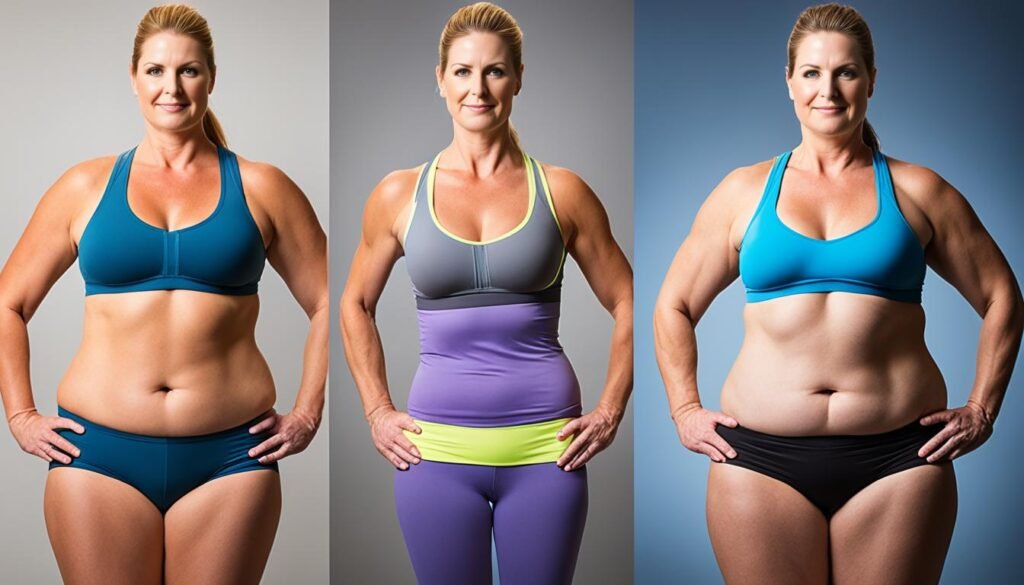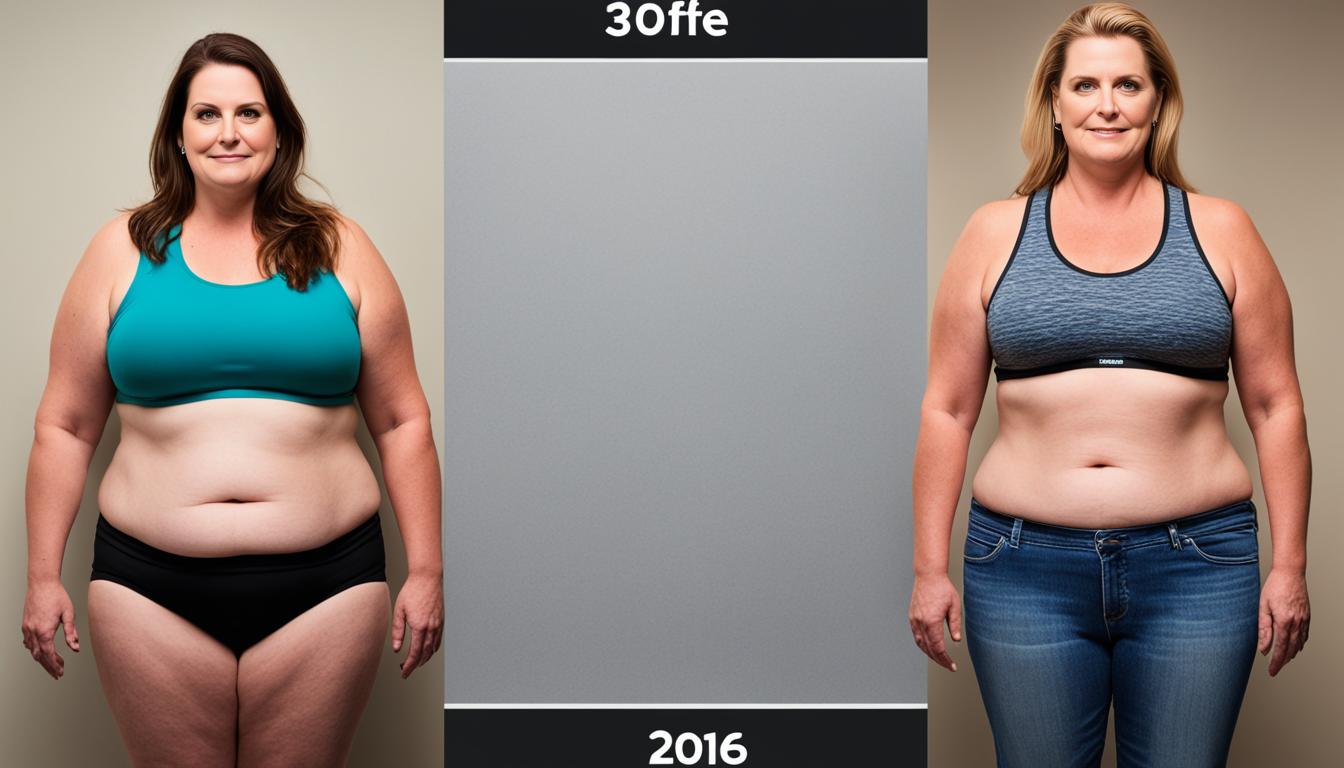What is the Most Dramatic Weight Loss?
When it comes to weight loss, many people are searching for the most dramatic transformations. From extreme weight loss to incredible transformations, there is a fascination with the idea of achieving impressive results in a short amount of time. But what exactly does it mean to have a drastic weight loss? And is it safe or sustainable?
Rapid weight loss diets are often chosen by individuals with obesity who are looking to shed pounds quickly. These diets involve consuming very few calories and can result in significant changes on the scale. Two types of rapid weight loss diets that are frequently recommended are very low-calorie diets (VLCDs) and low-calorie diets (LCDs).
VLCDs typically provide around 800 calories a day and can lead to a weekly weight loss of up to 3 to 5 pounds. LCDs allow for slightly more calories, usually ranging from 1,000 to 1,200 calories a day for women and 1,200 to 1,600 calories a day for men. Other methods, such as intermittent fasting and time-restricted eating, have also been shown to cause rapid weight loss.
While rapid weight loss can be enticing, it’s essential to consider the potential risks and side effects. Gallstones, fatigue, and constipation are some of the challenges individuals may face when undertaking a dramatic weight loss journey.
Key Takeaways:
- Very low-calorie diets (VLCDs) and low-calorie diets (LCDs) are two types of rapid weight loss diets commonly recommended.
- VLCDs typically provide around 800 calories a day, while LCDs allow for slightly more calories, usually ranging from 1,000 to 1,200 calories a day for women and 1,200 to 1,600 calories a day for men.
- Other methods, such as intermittent fasting and time-restricted eating, can also lead to rapid weight loss.
- Rapid weight loss may not be safe or sustainable for everyone and can result in side effects such as gallstones, fatigue, and constipation.
- Consulting with a healthcare provider is crucial before starting any rapid weight loss diet, especially for individuals with underlying health conditions, children, teens, pregnant women, and older adults.
Very Low-Calorie Diets (VLCDs)
VLCDs, or very low-calorie diets, are a type of rapid weight loss diet that should only be undertaken under the supervision of a healthcare provider. These diets involve consuming as few as 800 calories a day, leading to significant weight loss of up to 3 to 5 pounds per week.
VLCDs often incorporate meal replacements, such as formulas, soups, shakes, and bars, to ensure that individuals receive all necessary nutrients despite the low calorie intake. These meal replacements are carefully formulated to provide the right balance of vitamins, minerals, and macronutrients.
Typically, VLCDs are recommended for adults with obesity who are preparing for weight loss surgery. These diets help individuals achieve significant weight loss, often resulting in improved surgical outcomes and reduced surgical risks.
However, it’s important to note that VLCDs should not be followed for more than 12 weeks, as prolonged adherence to such low-calorie diets can lead to nutrient deficiencies and other health complications.
To illustrate the potential benefits and considerations of VLCDs, here are some key points:
Benefits of VLCDs:
- Rapid weight loss: VLCDs can result in significant weight loss of up to 3 to 5 pounds per week.
- Meal replacements: Incorporating meal replacements ensures that individuals receive optimal nutrition despite the low calorie intake.
- Preparation for weight loss surgery: VLCDs are often recommended to help individuals reduce their weight before undergoing weight loss surgery, improving surgical outcomes.
Considerations of VLCDs:
- Supervised approach: VLCDs should only be undertaken under the guidance and supervision of a healthcare provider.
- Short-term duration: These diets should not be followed for more than 12 weeks to avoid potential nutrient deficiencies.
- Meal replacements: While meal replacements provide necessary nutrients, some individuals may find it challenging to adhere to a diet relying heavily on such products.
Overall, VLCDs can be an effective tool for rapid weight loss when used appropriately and under professional supervision. However, it’s essential to consult with a healthcare provider before initiating such a diet to ensure it aligns with individual health needs and goals.
Low-Calorie Diets (LCDs)
When it comes to rapid weight loss, low-calorie diets (LCDs) offer an alternative to very low-calorie diets (VLCDs) that may be more sustainable for long-term use. Unlike VLCDs, LCDs allow for a slightly higher calorie intake, typically ranging from 1,000 to 1,200 calories a day for women and 1,200 to 1,600 calories a day for men. While the calorie allowance is still restricted, it provides enough energy to support essential bodily functions and prevent extreme hunger.
In LCDs, meal replacements play a crucial role in supplying the necessary nutrients while keeping calorie intake controlled. These meal replacements can take the form of shakes, bars, soups, or formulas that are fortified with key vitamins, minerals, and proteins. By incorporating these meal replacements into their diet, individuals can ensure they are receiving the required nutrients, while still adhering to the calorie restrictions of the LCD.
Although LCDs result in significant weight loss, the rate of weight loss may be slower compared to VLCDs. However, this slower weight loss may be more sustainable in the long run, as it allows the body to adjust gradually and prevents drastic metabolic changes.
Benefits of LCDs
1. Slightly higher calorie allowance compared to VLCDs, reducing the risk of extreme hunger and deprivation.
2. Incorporation of meal replacements ensures adequate nutrient intake while limiting calorie consumption.
3. Gradual weight loss that may be more sustainable and prevent metabolic shock to the body.
Sample LCD meal plan:
| Meal | Calories |
|---|---|
| Breakfast: LCD shake | 150 calories |
| Morning Snack: Fresh fruit | 60 calories |
| Lunch: LCD bar | 200 calories |
| Afternoon Snack: Vegetable sticks with Greek yogurt dip | 100 calories |
| Dinner: Grilled chicken with steamed vegetables | 400 calories |
| Evening Snack: LCD shake | 150 calories |
It’s important to note that LCDs, like any rapid weight loss diets, should be approached with caution. Consulting with a healthcare provider is crucial before starting any restrictive diet, especially for individuals with underlying health conditions or specific dietary needs.
Remember, sustained weight loss and overall health improvement require long-term lifestyle changes, including healthy eating habits, regular exercise, and ongoing support.

Intermittent Fasting and Time-Restricted Eating
Intermittent fasting and time-restricted eating have gained popularity as methods for achieving rapid weight loss. Intermittent fasting involves alternating between periods of fasting and eating, while time-restricted eating limits the number of hours per day that one can eat.
One popular method of intermittent fasting is the 16:8 regimen, which involves fasting for 16 hours and having an 8-hour eating window. During the fasting period, only zero-calorie beverages such as water, black coffee, or tea are allowed. This approach allows individuals to control their calorie intake and may lead to rapid weight loss.
Research suggests that intermittent fasting can have various benefits for weight management, including decreased calorie consumption and improved insulin sensitivity. However, it is important to note that there is limited information on the long-term sustainability of intermittent fasting as a weight loss strategy.
Time-restricted eating, on the other hand, involves setting a specific window of time during the day for eating. For example, an individual may choose to eat only between 12 pm and 8 pm, effectively fasting for the remaining 16 hours of the day. This method helps regulate calorie intake and may promote weight loss.
While intermittent fasting and time-restricted eating can be effective for rapid weight loss, it is essential to approach these fasting regimens with caution and under the guidance of a healthcare provider. These methods may not be suitable for everyone, especially individuals with underlying health conditions or specific dietary needs.
It is important to approach intermittent fasting and time-restricted eating with caution and under the guidance of a healthcare provider.
Fad Diets and Unsustainable Methods
When it comes to weight loss, many people are drawn to fad diets that promise quick results. These diets often severely limit calories in an attempt to achieve rapid weight loss. However, it’s important to understand that these diets are often unsafe and not sustainable for long-term weight loss.
Most experts recommend a gradual and sustainable weight loss approach, aiming for a loss of 1/2 to 1 pound per week for most individuals. Rapid weight loss, on the other hand, can have negative effects on the body.
Severely restricting calories can lead to muscle loss, as the body breaks down muscle tissue for energy. This can have a negative impact on overall body composition and metabolism. Rapid weight loss also results in water loss, which can be misleading and not indicative of actual fat loss.
Moreover, fad diets that severely limit calories can cause a range of side effects, including the development of gallstones, gout, fatigue, constipation, and nausea. These unsafe diets do not provide the necessary nutrients for overall health and well-being.

Additionally, it’s important to note that individuals who lose weight quickly are more likely to regain the weight quickly once the diet is stopped or relaxed. Sustainability is crucial for long-term weight loss success.
Instead of falling for fad diets, it’s encouraged to adopt a balanced and sustainable approach to weight loss. This includes incorporating nutritious foods, practicing portion control, and engaging in regular physical activity.
Remember, no magic pill or extreme diet can replace the benefits of a healthy lifestyle for achieving sustainable weight loss and overall well-being.
Risks and Considerations
Rapid weight loss can have several risks and considerations that individuals should be aware of before embarking on a drastic weight loss journey. While rapid weight loss may seem appealing, it’s crucial to understand the potential consequences it can have on the body.
Muscle Loss and Water Loss
One of the significant risks of rapid weight loss is the potential loss of muscle mass. When the body is deprived of sufficient calories, it may start breaking down muscle tissues for energy, leading to muscle loss. This can have a negative impact on overall strength and physical performance.
In addition to muscle loss, rapid weight loss often involves a significant loss of water weight. This can be misleading, as the initial drop on the scale may seem substantial, but it is mainly due to water loss rather than fat loss.
Impact on Bone Density
Rapid weight loss can also affect bone health. Studies have shown that individuals who lose weight quickly may experience a decrease in bone density, which can increase the risk of osteoporosis and fractures.
Development of Gallstones, Gout, and Fatigue
Another potential risk of rapid weight loss is the development of gallstones. When the body breaks down fat rapidly, it produces more cholesterol, increasing the likelihood of forming gallstones.
Additionally, rapid weight loss can contribute to the onset of gout, a form of arthritis caused by the accumulation of uric acid crystals in the joints. This condition can cause severe pain and discomfort.
Extreme calorie restriction can also result in fatigue and low energy levels. Without proper nourishment, the body may not have enough fuel to support daily activities, leading to constant tiredness and weakness.
Digestive Issues and Nausea
Drastic changes in diet and reduced food intake can disrupt the digestive system and lead to constipation. The lack of fiber and nutrients can affect bowel movements and cause discomfort.
In some cases, rapid weight loss can cause nausea and even vomiting. This is often a result of the body’s struggle to adapt to the sudden changes and lack of essential nutrients.
It’s essential to understand that these risks can vary from person to person, and certain individuals may be more susceptible to specific side effects. Therefore, consulting with a healthcare provider before starting any rapid weight loss diet is crucial, especially for individuals with underlying health conditions, children, teens, pregnant women, and older adults.
By being aware of the potential risks and considerations associated with rapid weight loss, individuals can make more informed decisions about their weight loss journey and prioritize their overall well-being.
| Risks and Considerations | Impact |
|---|---|
| Muscle Loss and Water Loss | Loss of strength and physical performance |
| Impact on Bone Density | Increased risk of osteoporosis and fractures |
| Development of Gallstones, Gout, and Fatigue | Risk of gallstones and gout; fatigue and weakness |
| Digestive Issues and Nausea | Constipation, digestive discomfort, and nausea |
Inspiring Weight Loss Transformations
Throughout the years, there have been countless inspiring weight loss transformations that demonstrate the incredible achievements of individuals who have successfully shed a substantial amount of weight. These stories are a testament to the power of determination, resilience, and the willingness to make positive changes for one’s health and well-being.
Weight loss transformations don’t happen overnight. They are the result of a combination of factors, including adopting a healthier diet, committing to regular exercise, and having the determination to overcome obstacles along the way. It’s a journey that requires dedication and perseverance.
Some weight loss transformations are truly remarkable. Take for example John Smith, who lost an incredible 150 pounds through a disciplined exercise routine and a well-balanced diet. His story serves as a reminder that with dedication and hard work, achieving significant weight loss is possible.
“Losing weight has been one of the most challenging but rewarding experiences of my life. It required a complete lifestyle change, but the benefits have been beyond worth it. Not only do I feel more confident and energetic, but my overall health has improved significantly.” – John Smith
In addition to individuals like John, there are those who have undergone more drastic weight loss measures, such as gastric bypass surgery. This surgical procedure is often reserved for individuals with severe obesity and can result in considerable weight loss in a relatively short period.
Weight Loss Transformations: A Source of Inspiration
The stories of these incredible weight loss transformations serve as an inspiration and motivation for others on their own weight loss journey. They show that with commitment, perseverance, and the right mindset, significant weight loss is attainable.
These inspiring stories provide hope and encouragement to individuals who may be struggling with their weight or facing setbacks in their own journey. They remind us that change is possible and that transformation is within reach.
Weight Loss Transformation Table
| Name | Weight Loss (lbs) | Method |
|---|---|---|
| John Smith | 150 | Exercise and Healthy Diet |
| Sarah Johnson | 120 | Gastric Bypass Surgery |
| Michael Anderson | 100 | Intermittent Fasting |
These incredible weight loss transformations highlight the impact that dedication, determination, and a positive mindset can have on achieving significant weight loss. They demonstrate that weight loss is not only about physical changes but also about improving overall health and well-being.
Join us in celebrating these inspiring individuals and their incredible weight loss transformations. May their stories serve as a reminder that with hard work, persistence, and the right support, anyone can achieve their weight loss goals.
Conclusion
Achieving weight loss success and maintaining a healthy lifestyle require dedication and a personalized approach. It’s important to choose a safe and sustainable weight loss plan that aligns with your individual health goals and preferences. While rapid weight loss diets may offer short-term results, they may not be suitable or safe for everyone. Consult with a healthcare provider before starting any drastic weight loss program.
Remember that long-term weight loss and overall health involve more than just a quick fix. Lifestyle changes, such as adopting healthy eating habits, engaging in regular physical activity, and seeking ongoing support, are crucial for maintaining weight loss and achieving your health goals. These changes should be personalized to fit your needs and be sustainable in the long run.
By making lifestyle modifications and embracing a holistic approach, you can experience weight loss success and achieve your health goals. Focus on nourishing your body with nutritious foods, finding enjoyment in physical activity, and surrounding yourself with a supportive network. Remember, weight loss is a journey, and with the right mindset and tools, you can create lasting change and live a healthier, happier life.
FAQ
What is the most dramatic weight loss?
The most dramatic weight loss refers to a significant and impressive amount of weight loss achieved by individuals through various methods, such as very low-calorie diets, low-calorie diets, intermittent fasting, or surgical interventions.
What are Very Low-Calorie Diets (VLCDs)?
Very low-calorie diets (VLCDs) are rapid weight loss diets that involve consuming as few as 800 calories a day. They often utilize meal replacements and are recommended for adults with obesity who are preparing for weight loss surgery.
What are Low-Calorie Diets (LCDs)?
Low-calorie diets (LCDs) are rapid weight loss diets that typically allow for slightly more calories than VLCDs. They range from 1,000 to 1,200 calories a day for women and 1,200 to 1,600 calories a day for men. LCDs may incorporate meal replacements and regular food to promote weight loss.
What is intermittent fasting and time-restricted eating?
Intermittent fasting involves alternating between periods of fasting and eating, while time-restricted eating limits the number of hours per day that one can eat. For example, the 16:8 method involves fasting for 16 hours and having an 8-hour eating window.
Are fad diets and unsustainable methods effective for rapid weight loss?
Fad diets that severely limit calories are often unsafe and not sustainable for long-term weight loss. Experts recommend a gradual weight loss of 1/2 to 1 pound per week for most individuals.
What are the risks and considerations of rapid weight loss?
Rapid weight loss can lead to muscle loss, water loss, and various side effects such as gallstones, gout, fatigue, constipation, diarrhea, and nausea. It’s important to consult with a healthcare provider before embarking on any rapid weight loss diet, especially for individuals with underlying health conditions.
Are there any inspiring weight loss transformations?
Yes, there have been numerous inspiring weight loss transformations where individuals have successfully lost a significant amount of weight through a combination of healthy diet changes, regular exercise, and commitment to long-term health goals.
How can one achieve weight loss success?
Achieving weight loss success requires choosing a safe and sustainable approach that aligns with individual health goals and preferences. This includes making healthy eating habits, engaging in regular physical activity, and seeking ongoing support.
Source Links
- https://www.mountsinai.org/health-library/special-topic/diet-for-rapid-weight-loss
- https://www.womenshealthmag.com/weight-loss/a29872439/inspiring-weight-loss-transformations/
- https://coach.nine.com.au/fitness/10-of-the-biggest-weight-loss-transformations-of-all-time/bd44abaf-1821-4855-a3a3-7aa8d1b859a4






